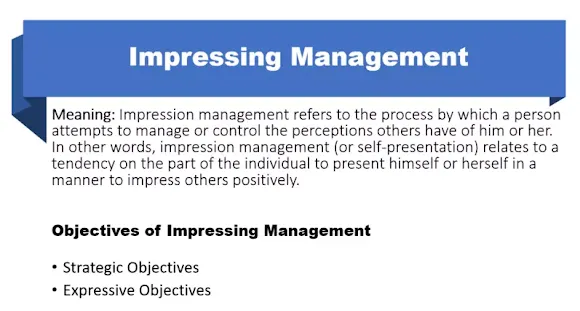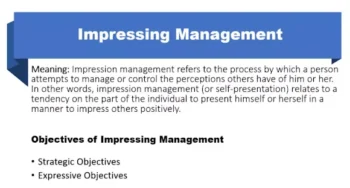Table of Contents:-
- Meaning of Impression Management
- Objectives of Impression Management
- Tactics of Impression Management
- Guidelines for Recognising Impression Management Strategies
Meaning of Impression Management
Impression management in ob: Impressing or Impression management refers to the process by which a person attempts to manage or control the perceptions others have of him or her. In other words, impression management (or self-presentation) relates to a tendency on the part of the individual to present himself or herself in a manner to impress others positively.
Accordingly, impression management is of utmost importance in organisations. It can help determine the validity of the appraisal. It has been noted that the appraiser may be manipulated by the appraisee to assign higher ratings than what he or she. The process of impression management may also be deliberately used as a political device by an individual to climb the ladder of promotion in work settings. Again, as the fine art of looking good, it may be used by job applicants to obtain jobs of their choice.
In social psychology and sociology, impression management is a goal-directed conscious or unconscious process in which someone attempts to influence the perceptions of other people about a person, object or event do so by controlling and regulating information in social interaction.
It is usually used synonymously with self-presentation, in which an individual tries to influence the perception of their picture.
Related Article:- Importance of Organisational Behaviour
The concept of impression management also refers to practices in public relations and professional communication, where the term is used to describe the process of the formation of a company’s or organisation’s public image.
According to Schlenber. “Impression management is defined as the unconscious or conscious attempt to control images that are projected in real or imagined social interactions”.
According to Brown, “Self-presentation is any behaviour intended to create, modify, or maintain an impression of ourselves in the minds of others”.
Related article: Job satisfaction
Objectives of Impression Management
Objectives of impression management can be classified into two groups:
1) Strategic Objectives: The strategic ones aim to manipulate the audience, often for ulterior ends. A taxonomy of five strategic motives was provided by Pittman and Jones. They noted that a person may seek to persuade others that he is competent (which they called self-promotion), to induce others to like him (ingratiation), to get them to regard him as dangerous (intimidation), to view him as a morally respectable individual (exemplification), or to take pity on him as helpless and needy (supplication).
These motives suggest ways that someone may seek to manipulate others. Thus, they are more likely to hire him if he succeeds at self-promotion, more likely to spend time and form relationships if he succeeds at ingratiation, more likely to help and support him if he succeeds at supplication, and so forth than if he fails. In such cases, self-presentation is guided by the audience’s standards and beliefs, and the self-presenter strategically seeks to secure some benefit by making the optimal impression.
2) Expressive Objectives: These for self-presentation involve claiming desired identities for the self. Self-presentation is based more on the self-presenter’s standards and values than on the audience. Sometimes people will seek to prove to others that they are not what the other people expect or want that they refuse to go along with what others want them to do, that they hold values and opinions that differ from those of others, and so forth. These expressive motives reflect the point that identity requires social validation.
Tactics of Impression Management
Tactics of Impression management that the person may adopt are as follows:
1) Ingratiation
This is a class of strategic behaviours illicitly designed to influence a particular other person concerning the attractiveness of one’s personal qualities. The goal of ingratiatory is being likeable. This involves complimenting another person or indulging in flattery with a certain amount of credibility and honesty. It also involves conforming, to another person’s viewpoint. It has been observed that we like people who act or think like us. Thus, presenting ourselves, in the same way, can generate a favourable response from others.
2) Intimidation
In this strategy, the individual arouses fear among others to get the work done. He does not care about being friendly, all he wants is to exercise his powers and control others. Intimidation usually works only in non-voluntary relationships, e.g., when it is hard for workers to find another employer or for an economically dependent spouse to leave a relationship.
Obvious pressure tactics include threats and the withholding of valuable resources (salary increase, sex, promotion). A more subtle tactic is emotional intimidation-holding over a person’s head the threat of an aggressive outburst if a person does not get his way. The other self-presentation strategies work by creating a favourable impression; intimidation usually generates dislike. Nonetheless, it can work.
3) Self-Promotion
This is a kind of advertising. The self-promoter wants to be seen as capable in certain areas. He may acknowledge minor flaws in his skills while emphasising stronger points of his personality. However, if his claims do not match his capabilities, then he may make a very bad impression. The motive behind self-promotion is earning respect. An individual does so by playing up his strong points so he will be perceived as competent.
For example, in a job interview, a person might find ways to mention that he earned high honours at school and that he was president of the student body and a member of the soccer team. To keep from coming across as a braggart, he should not go overboard with self-promotion. For this reason, false modesty usually works well.
4) Exemplification
In this strategy, the individual tries to elicit the impression of moral worthiness and integrity while creating a feeling of guilt among others. When someone says, “I will complete this work even if I fall sick but you go and enjoy”, he is using this strategy.
5) Supplication
In this strategy, the person advertises his weaknesses to get sympathy. The person portrays himself as helpless to get help from others. This is usually the tactic of the final resort. To get favours from others, individuals try to present themselves as weak and dependent.
Although a person may use all five tactics on different occasions, some people specialise in one or two tactics. Sometimes they use more than one method to influence others. Self-presentation tactics seem to be a matter of selecting certain characteristics and omitting others rather than deliberate deception.
Some people may stick to one tactic for so long that it may become an invariant part of their personality. Impression management is neither good nor bad, it is an essential part of our social interaction and everyone gets involved in it every day.
Guidelines for Recognising Impression Management Strategies
The following guidelines can be used by organisational members to recognise Impression management strategies:
1) An individual should be on the lookout for high-probability impression management strategies.
For example, recruiters should be careful to separate pure legitimate and self-promotion claims of competence, and those in positions of status or power should be aware of subordinates’ efforts to ingratiate themselves ( “apple-polishing” & “buttering up the boss”).
2) There should be an attempt to minimise situational, personal, and organisational features that foster undesirable impression management.
For example, organisations in which task performance is ambiguous and resources are scarce tend to develop relatively high levels of ingratiation.
3) One should look for ulterior motives and avoid being too influenced by impression management.
For example, a manager who can distinguish between pure self-promotion and true competence is less likely to be biased by an invalid claim when appraising a staff member’s performance.

You May Also Like:-
Nature of Organisational Behaviour
Conceptual Foundation of Organisational Behaviour
Contributing Disciplines to organisational behaviour
Models of Organisational Behaviour
Approaches of Organisational Behaviour
Emotional Intelligence in Organisational behaviour
Factors Influencing Perception
Scope of Organisational Behaviour
Importance of Organisational Behaviour
Challenges and Opportunities of Organisational Behaviour
Factors affecting group behaviour
Causes of Conflict in an Organisation
Types of Conflict in an Organisation
Organisational Development Process
Factors Affecting Organisational Culture
Trait Theory: Stogdill’s trait factors
Transactional Analysis in organisational behaviour
